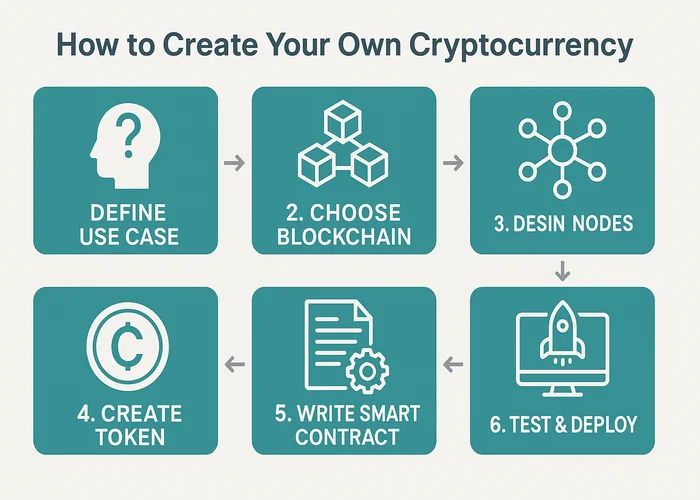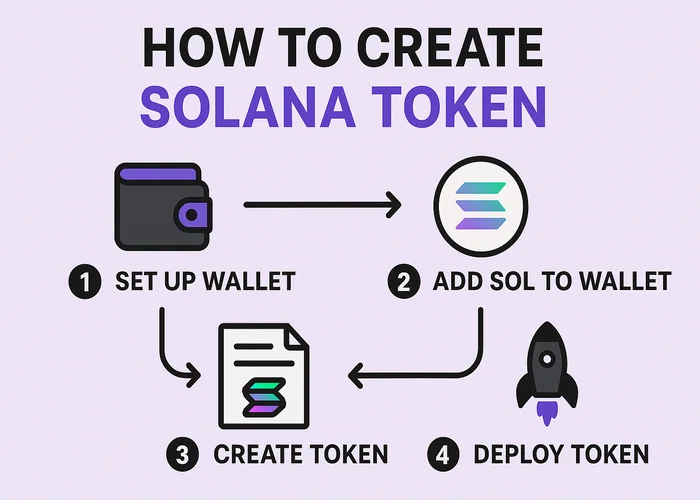Understanding the Basics: Token vs. Coin
Before discussing expenses, it’s important to grasp the distinction between token and coin development, which greatly affects cryptocurrency creation costs.
Tokens: Cost-effective option
Tokens are built on Ethereum, Binance Smart Chain, or Solana. Creating your own token uses existing infrastructure, lowering cryptocurrency development costs. Popular token standards:
Ethereum ERC20 tokens
Binance Smart Chain BEP20 tokens
Solana SPL tokens
Most budget-conscious cryptocurrency creators choose tokens, which cost $3,000 to $50,000.
Coins: Premium Route
Using their own blockchain, coins give maximum flexibility and control. But building a crypto currency costs $50,000 to over $500,000. This option needs substantial development and upkeep.
Breaking Down the Costs: How Much Does It Cost to Create a Cryptocurrency?
1. Costs of Choosing and Building a Platform
The blockchain platform you choose has a direct effect on how much does it costs to create a cryptocurrency or price to create a cryptocurrency token:
Ethereum (ERC20):
Making a basic token costs between $5,000 and $15,000.
Deployment gas fees range from $500 to $5,000.
Smart contract check: $5,000 to $30,000
BEP20: Binance Smart Chain
Creating a basic token costs between $3,000 and $10,000.
Gas fees are lower, between $50 and $500.
Smart contract audit: $3,000 to $20,000
Solana:
Making tokens costs between $2,000 and $8,000.
Low transaction fees: $10 to $100
Smart contract audit costs between $5,000 and $25,000.
If you want to make a crypto token on Solana, you’ll save money on transactions, but you could have to pay more for development because it requires specific knowledge.
2. Making smart contracts
Your cryptocurrency is built on smart contracts. How Much Does It Cost to Launch a Cryptocurrency is totally depends on how complicated it is:
Basic smart contracts cost between $3,000 and $10,000.
$10,000 to $30,000 for intermediate features like staking and governance
Advanced features (DeFi integration, complicated tokenomics): $30,000 to $100,000
Your smart contracts will be safe and work well if you use an expert ERC20 token development company or BEP20 token creation company.
3. Safety and Checking
When figuring out how much does it costs to create a cryptocurrency, security is not up for debate. Professional audits are very important to create your own cryptocurrency
A basic security audit costs between $5,000 and $15,000.
Full audit: $15,000 to $50,000
$50,000 to $100,000 for more than one audit firm
Monthly cost of ongoing security monitoring: $2,000 to $10,000.
4. Legal and Compliance Costs
It’s very important to know how much does it costs to create a cryptocurrency,. Following the cryptocurrency development costs more to generate cryptocurrencies:
Legal advice costs between $5,000 and $20,000.
Token categorization analysis costs between $10,000 and $30,000.
Filing with the government: $15,000 to $50,000
Compliance that keeps going: $3,000 to $15,000 a month
The ultimate cost to build a crypto coin depends on the rules in different places.
Step-by-Step Process: How to Create Your Own Cryptocurrency
#1 Define Your Objectives.
The first thing you need to do is figure out why you want to make a cryptocurrency. Not everyone who creates a project like this wants to beat Ethereum and Bitcoin as the best. There are times when you want something little. For example, cryptos are fantastic for raising money, boosting brand recognition, or starting a rewards program.
To fix the price to create a cryptocurrrency token, your goal will help you figure out how big the project is and how to effectively go forward at each level.
#2 Choose a Consensus Algorithm
Decentralization is one of the main ideas behind cryptocurrencies and to create your own token. Cryptocurrencies use consensus methods to check transactions on the blockchain in order to keep this decentralized structure.
To fully understand how cryptocurrencies work on a secure and open blockchain architecture, you need to know how this mechanism works in detail.
Proof of work (PoW) and proof of stake (PoS) are the two most common ways to reach consensus. These are all very important ways to make sure that cryptocurrency transactions are safe and valid:
Proof of Work (PoW): The PoW consensus process has many people, usually called miners, compete to validate a transaction. They do this by doing complicated math with cryptography. The first miner to correctly do these calculations gets a token or coin as a reward for their hard work. Because of its strong security characteristics, PoW is a popular choice for many bitcoin networks.
Proof of Stake (PoS): The PoS consensus process, on the other hand, works in a different way. Here, validators, or those who take part, have to put up a particular amount of cryptocurrency as a stake. The more money you put in, the more likely it is that a validator will be picked to add new blocks to the blockchain and confirm transactions. But validators could lose their share if they act dishonestly or make mistakes. People praise PoS for being better for the environment because it uses a lot less energy than PoW.
People who are making cryptocurrencies must decide between these two consensus techniques. PoW is known for being very secure, while PoS is a better choice for the environment and the long term. There is no one right solution for everyone when it comes to choosing the best consensus process. The choice should be in line with the goals of your coin and the goals you want to reach within the blockchain architecture.
#3 Pick a platform for blockchain.
#4 Create the Nodes
Nodes are the machines that make up the blockchain network. They run the software protocol, check transactions, and maintain the network safe.
At this point, you need to make a few decisions: Are the nodes going to be public or private? Will you have them on the premises or in the cloud? How many nodes are there? What kind of operating system will they use?
#5 Plan the Internal Structure
Now you need to put together the internal structure. This stage is really critical since once you get online, you can’t go back. You need to make certain crucial choices about the accessibility and Steps to Launch a Crypto Token, in addition to the technological side of things:
Set rules for who can create, access, and validate new blocks;
Make the rules for issuing assets;
Make a system for managing the preservation and storage of private keys;
Choose how many digital signatures your blockchain needs to check the transactions;
Estimate the block size, block reward, transaction limitations, and so forth;
Guess how many pennies you will give.
#6 Generate a Wallet Address
#7 Connect the APIs
Platform-Specific Considerations
Creating Tokens on Ethereum
Ethereum is the most well-known platform in the token ecosystem, therefore when you think about how much does it cost to create a cryptocurrency on Ethereum, you should think about that. Ethereum was the first to use smart contracts, and its ERC20 standard is still the best way to make tokens. The platform works with wallets, exchanges, and DeFi protocols better than any other, making it the best solution for serious projects.
When you work with ERC20 token development companies, you may use a lot of different tools and resources. The Ethereum community has developed a lot of documentation, libraries, and frameworks that make it easier to build things. Because the infrastructure is so well-developed, developers can focus on adding new features instead of having to build basic functionality from scratch.
But the fact that Ethereum is popular means that it costs more. Depending on how busy the network is, gas expenses for implementing smart contracts can be anywhere from $500 to $5,000. During busy times, these fees might go up a lot, which can raise the costs of deploying and doing business. This means that Ethereum is not as good for projects that need to make a lot of minor transactions.
The average of how much does it cost to create a cryptocurrency on Ethereum is between $15,000 and $75,000. This covers building smart contracts, checking for security holes, and putting them into use for the first time. Many projects select Ethereum even though it costs more because it has a good security record and a large user base. They see the extra cost as an investment in stability and reach.
If you want to how to launch a crypto token successfully or
read our other blogs too.
Creating Tokens on Binance Smart Chain
Binance Smart Chain became a popular choice for people who wanted to lower the cost of developing cryptocurrencies without losing any features. BSC is compatible with Ethereum and has much cheaper transaction costs. This makes it a good choice for projects with tight resources or those that want to use it for high-frequency trading.
BEP20 token development companies use BSC’s efficient architecture to speed up the process of getting their tokens out there. The network processes transactions faster than Ethereum, with block times of about 3 seconds compared to Ethereum’s 13 seconds. This performance advantage means that token initiatives may give users a better experience and save money on running costs.
Startups really like the way BSC handles costs. Gas fees for deploying a contract usually vary from $50 to $500, which is 90% less than what Ethereum charges. This huge cost savings applies to all token operations, which makes BSC perfect for gaming tokens, yield farming initiatives, and other uses that need to make a lot of transactions.
If you make your own token on BSC, the entire cost will be between $10,000 and $50,000. This comprises costs for development, auditing, and deployment. BSC has the same smart contract features as Ethereum, so you don’t have to give up any features to get a lower pricing. This means you can use intricate tokenomics and DeFi integrations.
How to Create Solana Token?
Solana is the most advanced blockchain technology available, with speeds and scalability that have never been seen before. If you’re wondering how to create Solana token projects, the platform is a great choice because it works well and doesn’t cost a lot. Solana can handle more than 65,000 transactions per second, which is a lot more than Ethereum and BSC.
Creating a crypto coin on Solana is very different than creating one on EVM-compatible networks. Instead of Solidity, Solana uses Rust and C programming languages, which means developers need to know a lot about them. This technological difference can change how much does it cost to create a cryptocurrency because Solana developers are frequently paid more because they have specialized abilities.
Create a crypto token on Solana may cost developers more, but it saves a lot of money on operational expenditures. Transaction fees are very low, usually less than $0.001 for each one. Solana is great for apps that need microtransactions, such gaming tokens, social tokens, or platforms for high-frequency trading. Because the platform is so efficient, projects can offer capabilities that would be too expensive on other blockchains.
Cost to create your own crypto token usually stays between $8,000 and $40,000 to start your own coin on Solana. The lower end could look good, but projects should plan for the higher end because they will need specialized development skills. The platform’s ecosystem is evolving, and it already includes tools like Metaplex for NFT functionality and Serum for DEX integration, which bring value beyond just making tokens.
Emerging Platform Considerations
There are also newer blockchains that offer distinct benefits for certain use cases, in addition to the major ones. Polygon is a good choice for projects that desire Ethereum’s environment without having to pay for it because it is cheaper than Ethereum. Avalanche lets you create your own blockchain and offers finality in less than a second, making it perfect for institutional applications that need certain compliance requirements.
When figuring out how much does it cost to create a cryptocurrency on newer platforms, think about the pros and downsides very carefully. These platforms may have reduced costs and new features, but they may not have as many tools, documentation, or users as established chains. This could make development take longer and make it harder to get people to use it at first, which could cancel out any savings.
The platform you choose has a big effect on both the initial cost of developing a coin and its long-term viability. Think about the platforms your target audience likes most, how easy it is to find development resources, and how mature the ecosystem is. If the platform you choose doesn’t have the infrastructure to sustain your project’s growth, a lower starting cost doesn’t mean anything.
In the end, the platform you choose should fit the demands and goals of your project. Solana’s speed is great for projects with a lot of transactions, Ethereum’s large ecosystem is typically needed for DeFi initiatives, and BSC’s ease of use is great for community tokens. When you produce your own cryptocurrency and make money, knowing these small details can help you get the best results and save money.
Hidden Costs to Consider
1. Liquidity Provision
Any cryptocurrency project that wants to be successful needs liquidity. If your token doesn’t have enough liquidity, it will be hard to trade, which will cause prices to change a lot and make the user experience bad. When planning their cryptocurrency development costs, a lot of projects don’t take this important factor into account.
Depending on how big your project is, initial liquidity pools usually need between $10,000 and $100,000. This isn’t a one-time cost; you’ll need to keep liquidity up and maybe even raise it as your project expands. The amount depends on things like how much trading is expected to happen, how many trade pairs there are, and which exchanges you want to use.
Market making services are another continuous cost of liquidity. To keep their order books robust and lower price spreads, professional market makers charge between $5,000 and $20,000 a month. Market making is optional for small projects and to create your own cryptocurrency and make money, but it becomes necessary as you grow. This directly affects the actual cost of generating your own crypto currency.
2. Exchange Listings
When you start your own cryptocurrency, one of the fees that can alter the most is the cost of getting it listed on exchanges. The easiest way to get started is through decentralized exchanges (DEXs), which charge between $1,000 and $10,000 to list. These usually include making the first pool and doing marketing.
Centralized exchange (CEX) listings cost a lot more than other types of listings. Fees for listing on top-tier exchanges might range from $50,000 to $500,000 or more. These fees don’t always mean that your listing will be approved. Many exchanges undertake a lot of research and may turn down projects that don’t fit their requirements.
Exchanges may charge recurring fees or require a minimum amount of trading volume in addition to the initial listing fee. Some exchanges work on a pay-to-play premise, which means that you have to spend more to get more exposure for your promotions. These hidden costs can add up rapidly, so having a good exchange strategy is an important part of your entire budget.
Costs also depend on when exchange listings happen. Listing on a lot of exchanges right after debut sometimes costs more than rolling out slowly. Strategic planning can lower these costs while also creating natural demand for your coin.
Some projects try to get more liquidity by giving people incentives or running liquidity mining activities. This can lower initial expenses, but it usually means setting aside a lot of tokens for awards, which means your overall investment goes up through dilution instead of direct costs.
3. Ongoing Maintenance
Making your own cryptocurrency costs a lot more than just the initial creation. You need to update your smart contracts as you introduce new functionality, repair problems, or respond to security holes. The cost of each update usually ranges from $2,000 to $10,000, depending on how hard it is and how much testing it needs.
Many projects forget about security monitoring, which is an important recurring cost. Professional monitoring services cost between $1,000 and $5,000 a month, but they are very important for keeping you safe from assaults and exploits. Because blockchain transactions can’t be undone, monitoring is a far cheaper way to stop security breaches than dealing with them after they happen.
To keep people interested and growing, community management needs devoted resources. Professional community managers charge between $2,000 and $8,000 a month, depending on how big the business is. This involves running social media accounts, monitoring conversations, answering user questions, and organizing community activities.
Maintaining technical infrastructure adds another layer of continuing costs. This comprises hosting servers for websites and APIs, backup systems, development environments, and tools for keeping an eye on things. Set aside at least $500 to $2,000 a month for basic infrastructure, and increase that amount as your enterprise grows.
Creating Your Own Cryptocurrency and Making Money
Create your own token and make money, this isn’t only about programming. There are different ways to make money, such as:
Fees for transactions: 0.1% to 3% of the amount
Rewards for staking: Encourage holding
Features that cost extra: Power users get advanced tools
Partnerships in the ecosystem: Sharing of income
Allocation of the Treasury: Tokens set aside for development.
Conclusion
Understanding how much does it cost to create a cryptocurrency is crucial to project success. Basic tokens cost $3,000, while complicated currencies cost $500,000+, however most projects spend $15,000–$75,000. Keep your budget in mind while ensuring security, functionality, and longevity.
Success needs careful planning, appropriate finance, and the right development partners to establish a token on Ethereum, Solana, or another platform. Understanding all costs and following the procedures to establish a crypto coin above can help you make smart decisions and prevent costly mistakes.
Remember that cryptocurrency development costs and to launch your own cryptocurrency are an investment in your project. Cutting security or compliance to build a cryptocurrency token cheaply generally leads to higher costs. Build a solid basis, and your cryptocurrency can become valuable in the burgeoning blockchain ecosystem.
Connect with us today to create your cryptocurrency at low cost. Talk to us.






